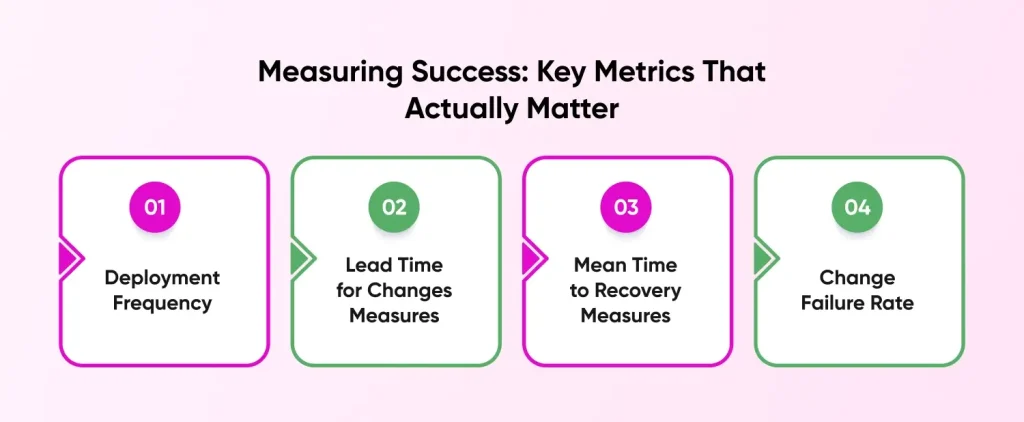Quick Summary: DevOps best practices help teams ship faster, catch issues earlier, and build more reliable systems. This blog breaks down 15 key practices every developer should know, with real-world automation examples, pitfalls to avoid, and metrics that matter.
The software development world has changed dramatically over the past decade. Developers used to finish their code, throw it over the wall to operations, and hope for the best. Those days are long gone. Today’s competitive landscape demands faster delivery, higher quality, and more reliable systems and that’s where devops best practices become absolutely critical for any serious development team.
Having worked with countless development teams across various industries, our dedicated DevOps teams witnessed firsthand how the right DevOps approach can completely transform an organization. Teams that embrace these practices don’t just ship code faster they ship better code with fewer bugs, and everyone sleeps better knowing their systems are rock solid.
Why DevOps Best Practices Are More Important Than Ever
DevOps isn’t just about adopting new tools or following the latest tech trends. It represents a significant change in how teams collaborate and think about the entire software lifecycle. When you implement DevOps For Enterprise environments, you’re not just changing processes you’re changing culture.
The Cultural Challenge Most Teams Face
The biggest obstacle in implementing DevOps best practices isn’t technical—it’s cultural. We have worked with companies where developers considered their job done once they pushed code to a repository. The operations team would then spend days trying to deploy and maintain that code in production. This disconnect created friction, delays, and countless production issues.
Breaking Down Traditional Silos
Today’s best devops practices eliminate these barriers completely. They create an environment where everyone shares responsibility for the complete software development lifecycle (SDLC), from initial development through production deployment and ongoing maintenance. This approach delivers three key benefits:
- Better Software Quality – When developers understand production requirements, they write more reliable code
- Faster Delivery – Eliminating handoff delays results in faster delivery of features to users
- More Stable Systems – Shared responsibility leads to proactive problem-solving rather than reactive firefighting
Market Growth Reflects Fundamental Change
The global DevOps market is to grow to $25.5 billion by 2028. This redefines how successful organizations approach software development and delivery.
15 Essential DevOps Best Practices Every Developer Should Master
1. Embrace Version Control as Your Foundation
Version control isn’t just about storing code—it’s about creating a reliable foundation for everything else you’ll build. The best devops platform solutions all start with robust version control practices that go far beyond basic Git usage.
Every change to your codebase should tell a story. Your commit messages should be clear enough that someone can understand what changed and why without diving into the actual code. We have saved considerable hours of debugging time just by maintaining proper commit hygiene. Branching strategies matter too—whether you choose Git Flow, GitHub Flow, or trunk-based development, consistency across your team is what really counts.
2. Master Continuous Integration Like Your Career Depends on It
In DevOps, continuous integration is where things really start to take off. The moment you push code, your CI pipeline gets to work—running tests, checking code quality, and giving you quick feedback. It’s more than just catching bugs early; it’s about having confidence that every change you make keeps your codebase reliable and ready to ship.
In our years of providing professional DevOps development services, we have worked with teams that went from weekly integration nightmares to seamless daily deployments just by implementing proper CI practices. Your build should be fast enough that developers don’t grab coffee while waiting, comprehensive enough to catch real issues, and reliable enough that a green build means something.
3. Implement Infrastructure as Code Without Compromise
Infrastructure as Code transforms how we think about servers, databases, and cloud resources. Instead of clicking through web consoles and hoping you remember all the configuration details, everything becomes versioned, testable, and repeatable.
The devops repository best practices extend beyond application code to include your infrastructure definitions. Tools like Terraform, AWS CloudFormation, or Azure Resource Manager templates let you treat your infrastructure with the same discipline you apply to your application code. When someone joins your team, they should be able to spin up a complete environment with a single command.
4. Build Comprehensive Automated Testing Strategies
Another DevOps best practice is understanding that testing isn’t just something the QA team handles anymore—it’s a shared responsibility. A solid testing strategy includes fast-running unit tests, integration tests to check how components work together, and end-to-end tests to make sure real user workflows behave as expected.
The key is finding the right balance. Most teams get so caught up in achieving 100% test coverage that they spend more time maintaining tests than building features. Focus on testing the critical paths and business logic that actually matter. Your devops continuous integration pipeline should give you confidence that broken code won’t make it to production.

5. Establish Robust Monitoring and Observability
You can’t fix what you can’t see. Modern applications are complex distributed systems, and traditional monitoring approaches just don’t cut it anymore. Comprehensive observability includes metrics that tell you what’s happening, logs that explain why it’s happening, and traces that show you exactly how requests flow through your system.
Your monitoring strategy should be proactive, not reactive. Instead of waiting for users to report problems, your systems should alert you before users are affected. The best devops consulting firms always emphasize that good monitoring pays for itself many times over by preventing outages and reducing mean time to recovery.
6. Implement Security Throughout the Development Lifecycle
Security can’t be an afterthought anymore. DevOps security best practices integrate security checks directly into your development workflow, making security everyone’s responsibility rather than a separate team’s problem.
This means running security scans in your CI pipeline, managing secrets properly, keeping dependencies updated, and designing systems with a security-first mindset. Many teams treat security as an afterthought which results in costlier implementation with weaker results.
7. Master Container Technologies and Orchestration
Containers have revolutionized how we package, deploy, and run applications. Docker and Kubernetes are must-have tools for modern devops software development, but they’re not magic solutions—they require proper understanding and implementation.
Containerization solves the “it works on my machine” problem by ensuring your application runs the same way everywhere. But containers are just the beginning—proper orchestration with tools like Kubernetes enables you to scale, update, and manage applications at enterprise scale. The learning curve is more on the steeper side, but the payoff makes this one of the DevOps best practices in terms of deployment flexibility and operational efficiency is enormous.
8. Embrace Cloud-Native Architecture Principles
Cloud devops best practices go beyond just running your applications in the cloud. Cloud-native architecture means designing applications specifically to take advantage of cloud platforms’ scalability, resilience, and managed services.
This includes using managed databases which enables auto-scaling capabilities, implementing proper cloud security practices, and designing for failure.
9. Implement Effective Configuration Management
Configuration management helps keep your systems running smoothly and consistently. Whether you’re using tools like Ansible, Chef, Puppet, or cloud-native solutions, the main goal stays the same: avoid unexpected differences (or “drift”) between systems and make updates easy to repeat and manage.
Many organizations spend days troubleshooting issues only to find out it was a configuration difference between environments. Proper configuration management eliminates these problems and makes your systems much more reliable. Every configuration change should be versioned, tested, and applied consistently across all environments.
10. Establish Comprehensive Backup and Disaster Recovery Procedures
Hoping for the best isn’t a disaster recovery strategy. As per DevOps best practices, your backup and disaster recovery procedures should be documented, tested, and automated. Many teams discover their backups in a corrupted or incomplete state when they actually needed them.
Regular disaster recovery testing is crucial—you need to know that your procedures actually work before you need them in a real emergency. The role of DevOps developer includes ensuring business continuity through proper backup and recovery planning.
11. Implement Effective Logging and Log Management
Logs are your window into what’s happening inside your applications and systems. But effective logging goes beyond just writing log messages—you need structured logging, centralized log collection, and powerful search and analysis capabilities.
Your logging strategy should help you debug issues quickly, understand system behavior, and identify potential problems before they become critical. Tools like ELK Stack (Elasticsearch, Logstash, Kibana) or modern alternatives like Grafana Loki can transform your logs from noise into actionable insights.
12. Master Database DevOps and Schema Management
Database changes are often the most challenging part of the deployment process. DevOps database practices include version controlling your schema changes, automating database deployments, and implementing proper database testing strategies.
Any database migrations should be automated, tested, and reversible. Too many deployments fail because of database issues that could have been caught earlier with proper database DevOps practices. Your database changes should go through the same review and testing process as your application code.
13. Implement Proper Secrets Management
Hardcoded passwords and API keys in your code are security disasters waiting to happen. Alternatively, DevOps best practices for proper secrets management involves using dedicated tools like HashiCorp Vault, AWS Secrets Manager, or Azure Key Vault to store and manage sensitive information.
Secrets should always be encrypted—at rest, in transit, and during use. Access to them needs to be logged and regularly audited, and rotation should happen on a consistent schedule. The best DevOps tools offer built-in management tools that plug right into your deployment pipeline.
14. Establish Effective Collaboration and Communication Practices
DeDevOps, at its heart, is not just about tools or automation—it’s about how people work together. That starts with clear communication so everyone’s on the same page. It also means having strong code review processes to catch issues beforehand and share knowledge across the team. Documenting decisions and workflows helps keep things transparent and easy to follow. Most importantly, DevOps encourages a culture where everyone takes ownership of the product—not just developers or ops, but the whole team.
Tools such as Slack, Microsoft Teams, or other collaboration platforms become essential for maintaining team communication. But tools alone aren’t enough—you need to establish practices that encourage collaboration and knowledge sharing across your team.
15. Implement Comprehensive Performance Monitoring and Optimization
Performance monitoring goes beyond just keeping your systems running—it’s about understanding how your applications behave under different conditions and continuously optimizing for better user experience.
DevOps best practices for performance monitoring application performance metrics, database query performance, infrastructure resource utilization, and user experience metrics. Performance optimization should be an ongoing process, not something you do only when users complain about slow response times.
DevOps Automation Examples: 15 Proven Areas to Streamline Your Delivery Process
| Automation Area | Description |
| Continuous Integration (CI) | Automates builds and test execution to catch errors early in development. |
| Continuous Delivery (CD) | Pushes validated code into production with minimal manual effort. |
| Infrastructure as Code (IaC) | Manages and provisions cloud resources using code-based definitions. |
| Configuration Management | Applies environment-specific settings across systems automatically. |
| Automated Testing | Runs unit, integration, and end-to-end tests to validate code automatically. |
| Release Orchestration | Automates app deployment and rollbacks . |
| Containerization | Packages applications with dependencies for consistent deployment. |
| Monitoring and Alerting | Sets up proactive alerts and health checks for system visibility. |
| Incident Management | Automates incident tracking, escalation, and communication processes. |
| Log Management | Centralizes and analyzes logs for real-time insights and diagnostics. |
| Security Automation | Integrates vulnerability scans and policy checks into CI/CD pipelines. |
| Performance Testing | Simulates loads to uncover performance bottlenecks early. |
| Environment Provisioning | Automatically spins up dev/staging/test environments on demand. |
| Backup and Recovery | Ensures consistent, scheduled backups and automated recovery workflows. |
| Deployment Rollbacks | Reverts deployments automatically in case of failures. |
Implementing these automation strategies ensures your DevOps practices scale reliably across teams and environments. It turns culture into consistent, executable workflows.
Critical Practices to Avoid in DevOps Implementation
Even with the best intentions, teams often make mistakes that can derail their DevOps journey. Here are some common pitfalls we have seen repeatedly across different organizations.
Don’t treat DevOps as just a tooling problem
Only buying the latest DevOps tools would solve all their problems. Tools are important, but culture and practices matter more. You can have the best tools in the world, but if your team doesn’t collaborate effectively, you won’t see the benefits.
Avoid implementing everything at once
DevOps transformation is a journey, not a destination. Teams that try to implement every practice simultaneously often become overwhelmed and abandon the effort. Start with foundational practices like version control and CI/CD, then gradually expand your capabilities.
Don’t ignore security until the end
Security should be built into your DevOps best practices from the beginning, not bolted on afterward. DevOps security best practices are much easier to implement when they’re part of your initial design rather than an afterthought.
Resist the urge to over-engineer solutions
Often, DevOps teams build incredibly complex deployment pipelines that nobody understands or can maintain. Start simple and gradually add complexity only when you actually need it.
Don’t neglect documentation and knowledge sharing
Your DevOps practices should be documented well enough that new team members can understand and contribute quickly. Knowledge silos defeat the purpose of DevOps collaboration.
Building Your DevOps Team: Internal vs External Expertise
One of the most important decisions organizations face is whether to build DevOps capabilities internally or leverage external expertise. Both approaches have merit, and the right choice depends on your specific situation.
When you Hire Dedicated Developers with DevOps expertise, you’re investing in long-term capability building. Internal team members understand your business context, can make decisions quickly, and provide continuity over time. However, building this expertise takes time and requires ongoing investment in training and skill development.
DevOps outsourcing can accelerate your transformation journey by bringing in experienced practitioners who have solved similar problems before. External experts can help you avoid common pitfalls and implement best practices more quickly. The key is finding partners who focus on knowledge transfer and capability building rather than just delivering services.
Many successful organizations use a hybrid approach—bringing in external expertise to jumpstart their DevOps transformation while simultaneously building internal capabilities. This approach provides immediate results while ensuring long-term sustainability.
Measuring Success: Key Metrics That Actually Matter

Implementing DevOps practices without measuring their impact is like driving with your eyes closed. You need concrete metrics to understand whether your efforts are paying off and where you need to focus improvement efforts.
Deployment Frequency
This tells you how often you’re delivering value to users. Teams with mature DevOps practices typically deploy multiple times per day, while traditional teams might deploy monthly or quarterly. More frequent deployments generally indicate better processes and higher confidence in your systems.
Lead time for Changes Measures
How long does it take from committing code to deploying it in production? This metric captures the efficiency of your entire development and deployment pipeline. Shorter lead times enable faster feedback and more responsive development.
Mean Time to Recovery Measures
How quickly can you restore service after a failure? This metric reflects both your monitoring capabilities and your incident response processes. The best teams can recover from most incidents in minutes, not hours.
Change Failure Rate
This indicates the percentage of deployments that cause production issues. Lower failure rates suggest better testing, more stable processes, and higher quality code. However, a zero failure rate might indicate you’re not taking enough risks or innovating quickly enough.
Final Words
As DevOps outsourcing continues to grow and adapt, it’s clear that the future will be shaped by smarter, faster, and more reliable ways of working. Teams are finding new ways to prevent issues before they start, reduce the manual load, and improve how updates are delivered. While the tools may change, the goal remains the same—building better systems, with less stress and more confidence.
FAQs on DevOps Best Practices
Which are Devops’ Best Practices?
Key DevOps best practices include continuous integration and deployment, infrastructure as code, automated testing, and comprehensive monitoring. Teams should focus on version control for everything, frequent small releases, and strong collaboration between development and operations with shared responsibility for the entire application lifecycle.
How to Approach Devsecops?
DevSecOps integrates security throughout the development pipeline by embedding security tools into CI/CD processes and implementing automated security testing. Teams should adopt security as code practices, conduct regular vulnerability assessments, and foster a culture where everyone takes responsibility for security from the beginning rather than treating it as an afterthought.
How Does “Shift-Left” Fit Into DevOps?
Shift-left moves testing, security, and quality checks earlier in the development cycle to catch issues when they’re cheaper and easier to fix. This approach reduces deployment risks and accelerates delivery by implementing automated testing in development environments and empowering developers to identify problems before code reaches production.
What Are the 7 Principles of DevOps?
The 7 key DevOps principles are: collaboration and shared responsibility, automation of repetitive processes, continuous integration and delivery, continuous monitoring and feedback, infrastructure as code, fail fast and learn quickly, and customer-centric focus. These principles work together to break down silos and accelerate delivery cycles.







